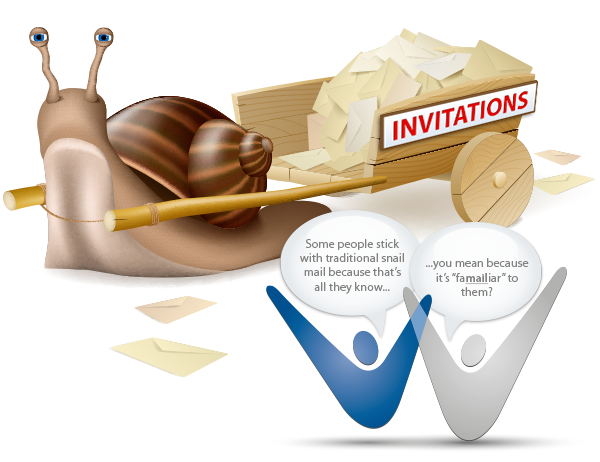
Email invitations – or “evites” – are gradually becoming more and more popular, but there is still the question of appropriateness when it comes to sending invitations to your donors. So which medium is best suited for inviting guests to your charity auction items event? The answer is it depends.
Following are some general guidelines to follow when deciding whether to send out your charity event invitations via email or traditional snail mail:
When to send a traditional invitation:
- Formal events: If you are having a formal gala where guests are requested to dress up, then it is best to play it safe and send a physical invitation.
- Exclusive events: If you are having a small exclusive event with less than 50 guests, then sending physical invitations is a must. Traditional snail mail holds a certain charm and tends to feel more personal than emails.
- Available contact information: Traditional snail mail invitations only work well if you have a well-organized database of donors and their addresses.
- Older target audience: Typically older groups are going to be less engaged online. However, this is a trend that is slowly changing as the population ages and the younger, more tech-savvy folks become your target demographic.
When to send an email invitation:
- Small budget: Sending email invitations is a great way to save a few hundred dollars since you don’t have to pay for paper, printing, postage, etc.
- Short timeline: Sending evites can also alleviate your workload if you’re running short on time. If your event is less than 30 days away, then an email invite is a must.
- Annual events: If you have the same (or similar) fundraising eventhappening around the same time every year then switching to evites can make sense – as long as it’s not a formal event.
- Cause: For some organizations, such as an environmental Nonprofit, going the paperless route makes more sense.
- Incomplete contact information: Donor email addresses are much easier to collect than physical addresses. If you are struggling with getting complete contact information for your donors and you know a majority of them can be reached through email, then an evite is the way to go.
- High online engagement: If your audience is actively participating on your social media pages, commenting on blog posts and opening your email newsletters, then an email invitation may be appropriate. It can also be a good way to go if you’ve also had some success with mobile bidding at your events and you know a majority of your target audience has and uses smartphones.
- Younger target audience: If your target audience is younger than 40, then they are likely very active online and are used to getting email invitations.
- Online event registration: If guests need to register and pay for their tickets online, then sending an email invite invitation with a link to the registration page will make it easier for recipients to RSVP.
When to send both:
- First-time events: If you are hosting an event for the first time and your goal is to get as many guests registered as possible, it may be appropriate to send invitations via both mediums to ensure you get full participation and to raise awareness about the event.
- To boost attendance: If your event attendance is waning and you want to expand your reach, then it may be worth the extra money to send both print and email invitations.
- Variable contact information: If you only have a partial list of physical addresses and email addresses in your contact database, then it’s worthwhile to send both types of invitations.
Get the most out of your email campaigns! Click here to download the free eBook, “Beginner’s Guide to Email Event Promotion,” with bonus content calendar to help plan and organize efforts.
{{cta(‘661274c0-1d2e-4806-a547-596f67dbe59d’,’justifycenter’)}}
